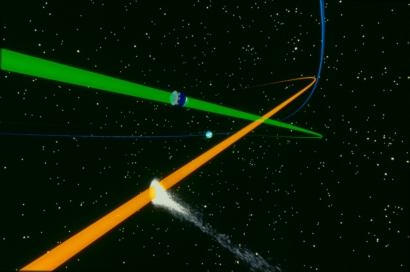This stratospheric dust includes minute grains that likely formed inside stars that lived and died long before the birth of our sun as well as material from molecular clouds in interstellar space. This 'ultra-primitive' material likely drifted into the atmosphere after the Earth passed through the dust trail of comet Grigg-Skjellerup, giving scientists a rare opportunity to study cometary dust in the laboratory.
Comets are thought to be repositories of primitive, unaltered matter left over from the formation of the solar system. Material held for eons in cometary ice has largely escaped the heating and chemical processing that has affected other bodies, such as the planets.

At high altitudes, most dust in the atmosphere comes from space, rather than the Earth's surface. Thousands of tons of interplanetary dust particles (IDPs) enter the atmosphere each year. "We've known that many IDPs come from comets, but we've never been able to definitively tie a single IDP to a particular comet," says study coauthor Larry Nittler, of Carnegie's Department of Terrestrial Magnetism. "The only known cometary samples we've studied in the laboratory are those that were returned from comet 81P/Wild 2 by the Stardust mission." The Stardust mission used a NASA-launched spacecraft to collect samples of comet dust, returning to Earth in 2006.
The Wild 2 dust returned by the Stardust mission included more altered material than expected, indicating that not all cometary material is highly primitive.
The IDPs collected by NASA aircraft in April 2003 from the dust trail of Grigg-Skjellerup were used by the research team, which included Carnegie scientists Nittler, Henner Busemann (now at the University of Manchester, U.K.), Ann Nguyen, George Cody, and seven other colleagues, who analyzed a sub-sample of the dust to determine the chemical, isotopic and microstructural composition of its grains. The results were reported on-line in Earth and Planetary Science Letters.
"What we found is that they are very different from typical IDPs" says Nittler. "They are more primitive, with higher abundances of material whose origin predates the formation of the solar system." The distinctiveness of the particles, plus the timing of their collection after the Earth's passing through the comet trail, point to their source being the Gregg-Skjellerup comet.
"This is exciting because it allows us to compare on a microscopic scale in the laboratory dust particles from different comets," says Nittler. "We can use them as tracers for different processes that occurred in the solar system four-and-a-half billion years ago."
The biggest surprise for the researchers was the abundance of so-called presolar grains in the dust sample. Presolar grains are tiny dust particles that formed in previous generations of stars and in supernova explosions before the formation of the solar system. Afterwards, they were trapped in our solar system as it was forming and are found today in meteorites and in IDPs. Presolar grains are identified by having extremely unusual isotopic compositions compared to anything else in the solar system. But presolar grains are generally extremely rare, with abundances of just a few parts per million in even the most primitive meteorites, and a few hundred parts per million in IDPs.
"In the IDPs associated with comet Gregg-Skjellerup they are up to the percent level," says Nittler. "This is tens of times higher abundances than we see in other primitive materials."
Also surprising is the comparison with the samples from Wild 2 collected by the Stardust mission. "Our samples seem to be much more primitive, much less processed, than the samples from Wild 2," says Nittler, "which might indicate that there is a huge diversity in the degree of processing of materials in different comets."





Comments